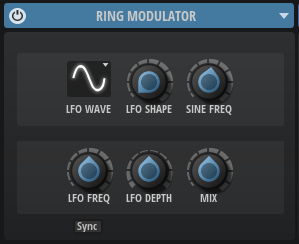Ring Modulator
The Ring Modulator provides a sine oscillator that is multiplied with the input signal. This creates metallic, or bell-like, frequencies.
The integrated LFO modulates the frequency of the sine oscillator to vary the created frequencies over time.

- LFO Waveform and Shape
-
Waveform selects the basic type of waveform. Shape changes the characteristics of the waveform.
-
Sine produces smooth modulation. Shape adds additional harmonics to the waveform.
-
Triangle is similar to Sine. Shape continuously changes the triangle waveform to a trapezoid.
-
Saw produces a ramp cycle. Shape continuously changes the waveform from ramp down to triangle to ramp up.
-
Pulse produces stepped modulation, where the modulation switches abruptly between two values. Shape continuously changes the ratio between the high and low state of the waveform. If Shape is set to 50%, a square wave is produced.
-
Ramp is similar to the Saw waveform. Shape adds a gradually increasing amount of silence before the sawtooth ramp up begins.
-
Log produces a logarithmic modulation. Shape continuously changes the logarithmic curvature from negative to positive.
-
S & H 1 produces random stepped modulation, where each step is different. Shape puts ramps between the steps and changes the S & H into a smooth random signal, with the control set fully to the right.
-
S & H 2 is similar to S & H 1. The steps alternate between random high and low values. Shape puts ramps between the steps and changes the S & H into a smooth random signal, with the control set fully to the right.
-
- Sine Freq
-
Determines the frequency of the sine oscillator.
- LFO Freq
-
Allows you to specify the frequency of the LFO for modulating the frequency of the sine oscillator.
- LFO Depth
-
Sets the intensity of the LFO modulation of the sine oscillator frequency.
- Mix
-
Sets the ratio between the dry and the wet signal.
- Sync
-
Allows you to set the LFO Freq value in fractions of beats.